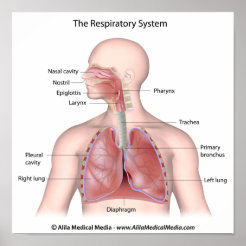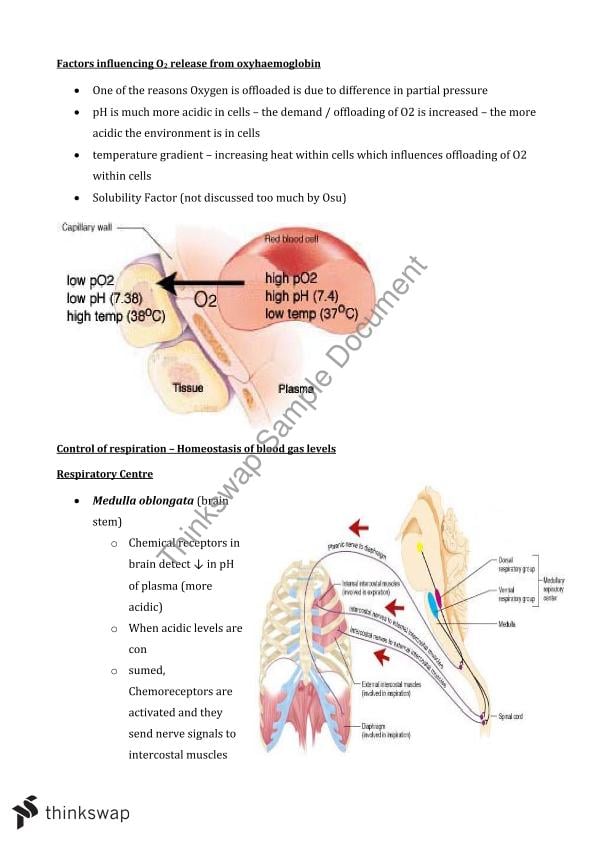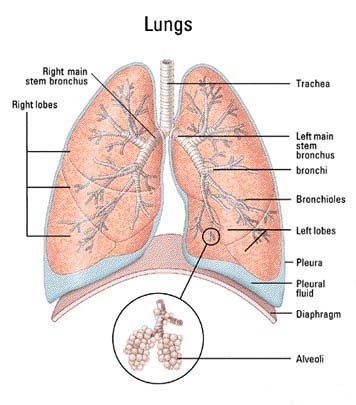45 respiratory system with labels and functions
16.2: Structure and Function of the Respiratory System Respiration by the respiratory system supplies the oxygen needed by cells for aerobic cellular respiration and removes the carbon dioxide produced by cells during cellular respiration. Respiration by the respiratory system actually involves two subsidiary processes. One process is ventilation or breathing. 21.1B: Functional Anatomy of the Respiratory System The primary function of the respiratory system is gas exchange between the external environment and an organism's circulatory system. In humans and other mammals, this exchange balances oxygenation of the blood with the removal of carbon dioxide and other metabolic wastes from the circulation. Bronchial anatomy: The pulmonary alveoli are the ...
Respiratory system: Anatomy and functions | Kenhub The main function of the respiratory system is pulmonary ventilation, which is the movement of air between the atmosphere and the lung by inspiration and expiration driven by the respiratory muscles. The respiratory system works as a whole to extract the oxygen from the inhaled air and eliminate the carbon dioxide from the body by exhalation.
Respiratory system with labels and functions
Amazon.com: Doctor's Best Quercetin Bromelain, Immunity ... Studies have shown that Quercetin can also support healthy airway function by maintaining a healthy balance of immune system cells within the respiratory system. DIETARY SUPPLEMENT - High Potency Bromelain 3000 GDU per capsule, has 500 Mg of Quercetin with 250 Mg Bromelain in a serving size of 2 Veggie Capsules ; Non-GMO and Gluten Free Respiratory System Anatomy and Physiology - Nurseslabs The functions of the respiratory system are: Oxygen supplier. The job of the respiratory system is to keep the body constantly supplied with oxygen. Elimination. Elimination of carbon dioxide. Gas exchange. The respiratory system organs oversee the gas exchanges that occur between the blood and the external environment. Passageway. Inspection procedures for the Respiratory Protection Standard ... Sep 25, 1998 · Respiratory Protection Program-1910.134(c)(1): A written respiratory protection program is required when necessary to protect the health of the employee from workplace contaminants or when the employer requires the use of respirators. A limited written program is also required when respirators (other than filtering facepieces) are being ...
Respiratory system with labels and functions. The 12 parts of the respiratory system (characteristics and functions ... Its main function is to bring air into the lungs when we inhale and expel it when we exhale. And since there are two lungs, the trachea, in its lowest region, bifurcates in two, giving rise to two tubes and each of them enters one of the lungs. 6. Lungs The lungs are the center of the respiratory system. 5 Functions of Respiratory System | Respiratory Anatomy - Visible Body The following are the five key functions of the respiratory system. 1. Inhalation and Exhalation Are Pulmonary Ventilation—That's Breathing The respiratory system aids in breathing, also called pulmonary ventilation. In pulmonary ventilation, air is inhaled through the nasal and oral cavities (the nose and mouth). Heart Diagram with Labels and Detailed Explanation - BYJUS The human heart is the most crucial organ of the human body. It pumps blood from the heart to different parts of the body and back to the heart. The Respiratory System - Diagram, Structure & Function - TeachPE.com March 24, 2021 The function of the human respiratory system is to transport air into the lungs and to facilitate the diffusion of oxygen into the bloodstream. It also receives waste Carbon Dioxide from the blood and exhales it. Here we explain the anatomy of the airways and how oxygen gets into the blood.
Respiratory System - Medical Terminology for Healthcare Professions The cilia of the respiratory epithelium help to remove mucus and debris with a constant beating motion, sweeping materials towards the throat to be swallowed. This moist epithelium functions to warm and humidify incoming air. Capillaries located just beneath the nasal epithelium warm the air by convection. 22.1 Organs and Structures of the Respiratory System The major organs of the respiratory system function primarily to provide oxygen to body tissues for cellular respiration, remove the waste product carbon dioxide, and help to maintain acid-base balance. ... Respiratory System: Asthma Asthma is common condition that affects the lungs in both adults and children. Approximately 8.2 percent of ... Respiratory System Organs and Their Functions - New Health Advisor The three major parts of the respiratory system all work together to carry out their task. The airways (nose, mouth, pharynx, larynx etc.) allow air to enter the body and into the lungs. The lungs work to pass oxygen into the body, whilst removing carbon dioxide from the body. The muscles of respiration, such as the diaphragm, work in unison to ... The Respiratory System (Label) Diagram | Quizlet Start studying The Respiratory System (Label). Learn vocabulary, terms, and more with flashcards, games, and other study tools.
Organs of the Respiratory System And Their Functioning The main function of respiratory system is to allow gas exchange (oxygen and carbon dioxide) with different parts of the body. The different organs of the respiratory system are nose, pharynx, epiglottis, larynx, trachea, bronchi and lungs. These organs carry out the process of respiration. The process of respiration is classified as aerobic ... Respiratory system diagram: Function, facts, conditions, and more The respiratory system allows people to breathe. It is made up of several organs and structures that transport air into and out of the lungs, exchanging oxygen with carbon dioxide. While the... Understanding the Respiratory System (interactive tutorial) 1. The Respiratory System: An Overview. The respiratory system is how we bring oxygen into our bodies so that it can be absorbed into the blood, and how we get carbon dioxide out of our blood, so that it can be exhaled from the body. Its key organs are. the lungs, which provide huge surface area for absorbing gases. Urinary System Flashcards | Quizlet Study with Quizlet and memorize flashcards containing terms like The three processes involved in urine formation are:, Contraction of the muscular bladder forces the urine out of the body through the:, When urine leaves the kidney it travels to the urinary bladder via the: and more.
Cardiovascular System – Medical Terminology for Healthcare ... We can detect and record the electrical activity of the heart’s conduction system using an electrocardiogram (ECG or EKG). Figure 9.7 shows the electrical impulse originating in the SA node (step 2) and traveling through the heart’s conduction system, allowing the heart to complete one cardiac cycle. Each waveform on the ECG tracing ...
Nervous System – Medical Terminology for Healthcare Professions The nervous system can be divided into regions that are responsible for sensation (sensory functions) and the response (motor functions), but there is a third function that needs to be included. Sensory input needs to be integrated with other sensations, as well as with memories, emotional state, or learning (cognition).
Respiratory System Parts and Functions for Kids - HowForKids Respiratory System: Lungs Function The lungs take up much of the space inside our chest (thorax). They are protected by the rib cage. This "cage" is formed by the ribs, and it surrounds the lungs to keep them safe. Below the lungs there's the diaphragm. It is a muscle that alternately rises and drops during the breathing process.
Respiratory System For Kids: Diagram, Parts, Functions, And Facts Your lungs take the oxygen from the air and expel the carbon dioxide that your body doesn't require. We need oxygen to survive and perform everyday tasks, such as moving our hands, opening our eyes, and even digesting food (1). The primary function of our respiratory system is to provide oxygen and expel carbon dioxide from the body.
Skin Diagram with Detailed Illustrations and Clear Labels - BYJUS Explore Skin Diagram with BYJU’S. Diagram of the skin is illustrated in detail with neat and clear labelling. Also available for free download
Respiratory System: Functions, Facts, Organs & Anatomy Your respiratory system is the network of organs and tissues that help you breathe. This system helps your body absorb oxygen from the air so your organs can work. It also cleans waste gases, such as carbon dioxide, from your blood. Common problems include allergies, diseases or infections. Appointments 216.444.6503 Appointments & Locations
13.2 Structure and Function of the Respiratory System Upper respiratory tract organs provide a route for air to move between the outside atmosphere and the lungs. They also clean, humidify, and warm the incoming air. No gas exchange occurs in these organs. Nasal Cavity The nasal cavity is a large, air-filled space in the skull above and behind the nose in the middle of the face.
Respiratory System Anatomy, Diagram & Function | Healthline The respiratory system, which includes air passages, pulmonary vessels, the lungs, and breathing muscles, aids the body in the exchange of gases between the air and blood, and between the blood and...
Human Respiratory System - BYJUS The functions of the human respiratory system are as follows: Inhalation and Exhalation. The respiratory system helps in breathing (also known as pulmonary ventilation.) The air inhaled through the nose moves through the pharynx, larynx, trachea and into the lungs. The air is exhaled back through the same pathway.
![[DIAGRAM] 5th Grade Science Respiratory System Diagram Quiz FULL Version HD Quality Diagram Quiz ...](https://i.pinimg.com/originals/16/7c/0a/167c0af686f9bf78dd13afa3c8e4dcde.png)
[DIAGRAM] 5th Grade Science Respiratory System Diagram Quiz FULL Version HD Quality Diagram Quiz ...
What is the Respiratory System: Diagram and Function Respiratory System Functions During inspiration, the rib cage moves outwards and upwards and the diaphragm lowers increasing the volume of the thoracic cavity. This causes the internal pressure in the lungs to be lower than the atmospheric pressure. The difference in pressure forces air (introducing oxygen to the alveoli) in to the lungs.
Chapter 9: THE RESPIRATORY SYSTEM - Anatomy & Physiology However, there are times that the respiratory system must alter the pace of its functions in order to accommodate the oxygen demands of the body. 22.6.1 Hyperpnea Hyperpnea is an increased depth and rate of ventilation to meet an increase in oxygen demand as might be seen in exercise or disease, particularly diseases that target the respiratory ...
Respiratory System - Definition, Function and Parts - Biology Dictionary Respiratory System Function Primary Function The primary function of the respiratory system is gas exchange. Animal cells use oxygen and produce carbon dioxide as a byproduct. Not only do animals need a way to get more oxygen into the cells, but they also need a way to remove carbon dioxide. The respiratory system provides this functionality.
Functions of the Respiratory System The respiratory system is made up of multiple small and large organs, bones, and muscles, which all work together to accomplish each task of the system. Broadly classified into the upper and lower respiratory tracts, here are the functions of the different parts: Upper Respiratory System Function of the Nose
Respiratory System • Anatomy, Parts & Functions - GetBodySmart The respiratory system is a complex system of organs and tissues that provide oxygen to the body and eliminate carbon dioxide. It is vitally important in maintaining homeostasis by regulating acid-base balance and pH. The respiratory tract comprises the nose, throat (pharynx), windpipe (trachea), bronchi and lungs.
Free Respiratory System Worksheets and Printables - Homeschool Giveaways We have created the Human Body Systems Labeling and Diagramming Worksheet as an instant download for your children. This respiratory system packet includes a fill in the blank diagram to fill in the trachea, bronchi, lungs, and larynx. Respiratory System Diagram - Download this free color diagram of the respiratory system for your kids.
human respiratory system | Description, Parts, Function, & Facts human respiratory system, the system in humans that takes up oxygen and expels carbon dioxide. The design of the respiratory system The human gas-exchanging organ, the lung, is located in the thorax, where its delicate tissues are protected by the bony and muscular thoracic cage.
How the Lungs Work - The Respiratory System | NHLBI, NIH The circulatory system, which is made up of the heart and blood vessels, supports the respiratory system by bringing blood to and from the lungs. The circulatory system helps deliver nutrients and oxygen from the lungs to tissues and organs throughout the body. It also helps remove carbon dioxide and waste products.
Respiratory system | healthdirect How your respiratory system works. You breathe in by contracting your diaphragm, a flat muscle at the base of your chest. This causes the chest to expand, drawing air in. You breathe air in and out through your nose and mouth. The air is warmed and moistened along the way. The air passes through your larynx, which contains the vocal cords that ...
:background_color(FFFFFF):format(jpeg)/images/library/11118/anatomy-of-respiratory-system_english.jpg)










Post a Comment for "45 respiratory system with labels and functions"